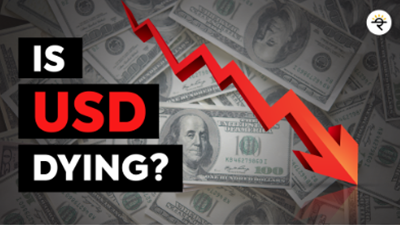Yesterday, Donald Trump who served as the president of the United States from 2017 to 2021, said that “Dollar is crashing and will soon no longer be the world standard”. This statement sparked speculation and concern about the future of USD & global trade.
Firstly, it's important to understand what it means for a currency to be the world standard. The US dollar has held this position since the end of World War II, largely due to the strength and stability of the US economy. As the world standard, many countries use the dollar as a reserve currency, meaning they hold large amounts of dollars in their foreign exchange reserves. Additionally, most international trade and financial transactions are conducted in dollars. This gives the US a significant amount of influence over global economic affairs.
However, Trump's warning that the dollar could lose its status as the world standard is not a new concern. Many countries, have been looking for ways to reduce their dependence on the dollar and increase their own currencies' importance on the global stage. This is also called as “de-dollarisation” move. It is in part due to concerns about US economic policy (e.g. heavy money printing by US in period of COVID lockdown) and the potential for sanctions that could hurt their economies (e.g. sanctions on Russia)
We can also see the below chart, which shows the declining % of USD in global forex reserves.

India is no exception to this de-dollarisation move. RBI has given permission to banks from 18 countries to open Special Vostro Rupee Accounts (SVRA) and use Indian rupees to settle payments. Renowned economist Nouriel Roubini, also known as 'Dr. Doom' by Wall Street, in February said that the Indian rupee over time could become one of the global reserve currencies in the world. China has also been stepping up the use of the Yuan as a trade settling mechanism. Last year, Yuan-denominated trade flows between Russia and China surged. Vladimir Putin said he supports using the Chinese Yuan for trade settlements between Russia, Asia, Africa and Latin America.
But it is not just about standalone countries, the BRICS ally is also reportedly exploring the creation of a common currency for trade amongst themselves. BRICS stands for Brazil, Russia, India, China and South Africa, which is an alliance of 5 powerful emerging countries. The BRICS countries represented 31.4% of the global GDP (2020), but its members hold less than 15% of the voting power at both the World Bank and the International Monetary Fund. This move by BRICS can also help it to gain influence in global market.
A new financial arrangement, seen with potential to translate into a common BRICS currency, could be announced as soon as August 2023 at the forthcoming BRICS summit in South Africa. The plan is to initially transition to using domestic currencies in transactions, and then explore the introduction and circulation of a digital or an alternative form of currency.
The potential challenge in the success of this move is the bilateral differences between India and China due to ongoing military standoffs along the Line of Actual Control between the two Asian giants. However, Babakov, the deputy chairman of the Russian parliament, the State Duma, believes that the BRICS leader’s summit will reveal preparedness to implement this particular initiative, with work on the project ongoing.
In conclusion, the dominance of the US dollar in global finance has led to many countries exploring ways to circumvent its usage. However, only time will tell if these initiatives will be successful in the long run.


